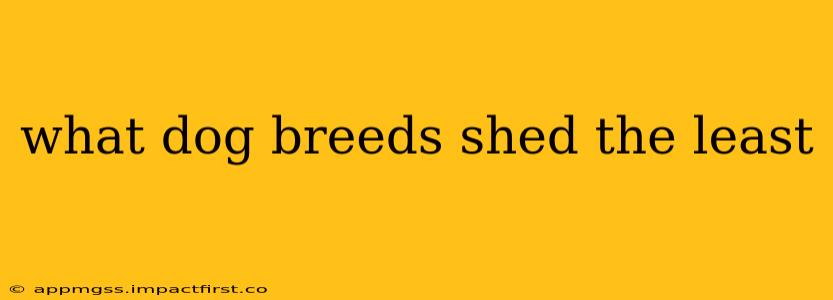Finding the perfect dog is a deeply personal journey, and for many, managing shedding is a key consideration. If you're dreaming of a furry friend without the constant battle against dog hair, you're in the right place. This guide explores dog breeds known for minimal shedding, helping you choose a canine companion that suits your lifestyle. We'll delve into the characteristics of these breeds and address common questions surrounding low-shedding dogs.
What are Hypoallergenic Dogs?
Before we dive into specific breeds, it's important to clarify the term "hypoallergenic." While no dog is truly 100% hypoallergenic, some breeds produce less dander (the protein in dog saliva and skin that triggers allergies) than others. This often translates to less shedding, making them a better choice for allergy sufferers. It's crucial to remember that even low-shedding dogs can cause allergic reactions in sensitive individuals, so it’s always best to spend time with a dog before committing to ownership.
Which Dog Breeds Shed the Least?
Several breeds are renowned for their low-shedding tendencies. These breeds are often chosen by people with allergies or those who prefer a cleaner home. Here are some top contenders:
Poodles (Standard, Miniature, Toy):
Poodles are consistently ranked among the top low-shedding breeds. Their curly coat requires regular grooming, but this helps to minimize shedding considerably. The frequency of grooming will depend on the length you keep their coat.
Bichon Frises:
These fluffy white companions have a soft, cotton-like coat that sheds minimally. They also require regular grooming to prevent matting.
Shih Tzus:
Shih Tzus possess long, silky hair that, if regularly groomed, sheds far less than many other breeds. However, this breed requires consistent brushing and professional grooming to avoid matting.
Yorkshire Terriers (Yorkies):
Yorkies have fine, silky hair that continuously grows rather than shedding seasonally. Regular brushing is essential to keep their coats healthy and prevent tangles.
Miniature Schnauzers:
Miniature Schnauzers have a wiry coat that requires regular grooming, minimizing shedding. They are often described as being fairly low-maintenance regarding grooming compared to other low-shedding breeds.
Do Low-Shedding Dogs Still Shed?
Even low-shedding dogs shed some hair. It's essential to manage this through regular brushing. While you won't face the same level of shedding as with a heavy-shedding breed, some hair will still come loose.
How Often Should I Groom a Low-Shedding Dog?
Regular grooming is critical for all low-shedding breeds. Brushing helps remove loose hair, prevents matting, and keeps their coats healthy. The frequency depends on the breed and coat type, but aiming for at least once or twice a week is recommended for most.
Are There Any Other Factors to Consider Besides Shedding?
Choosing a dog is about more than just shedding. Consider these factors:
- Energy levels: Some low-shedding breeds are energetic, requiring substantial exercise.
- Grooming needs: While low-shedding, regular grooming is still essential.
- Temperament: Ensure the breed's temperament aligns with your lifestyle and family.
- Training: All dogs need training, regardless of breed.
Conclusion: Finding Your Perfect Low-Shedding Companion
Selecting a low-shedding dog can significantly reduce the amount of hair around your home, but remember that even these breeds require regular grooming and may still cause allergic reactions in some individuals. Thorough research and careful consideration of your lifestyle and preferences will help you find the perfect furry friend. Remember to spend time with potential dogs before making a commitment to ensure a happy and harmonious relationship for both of you.
